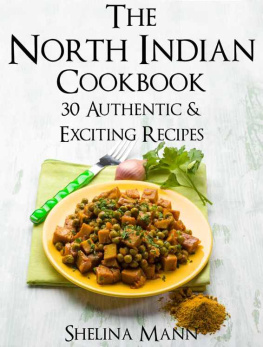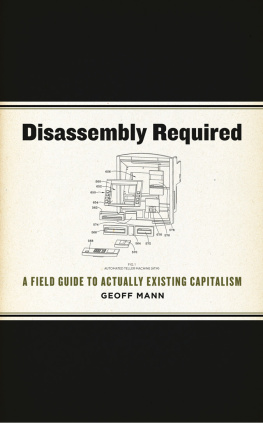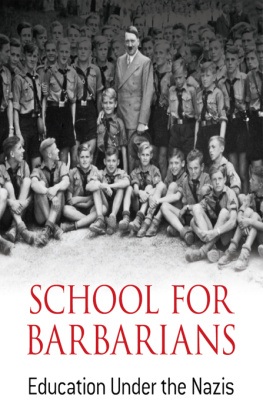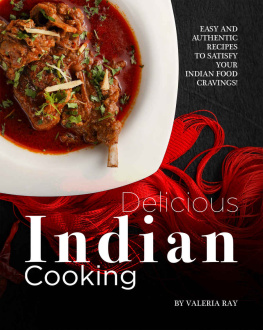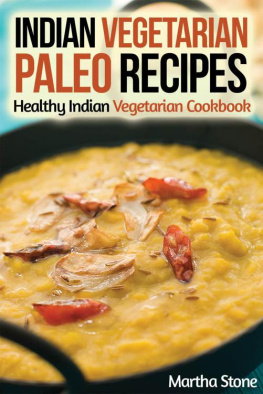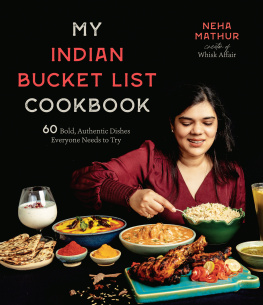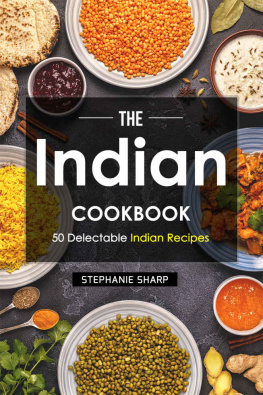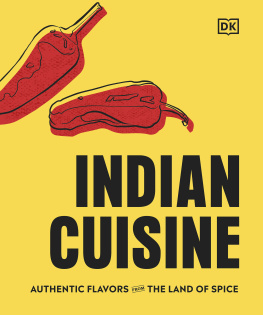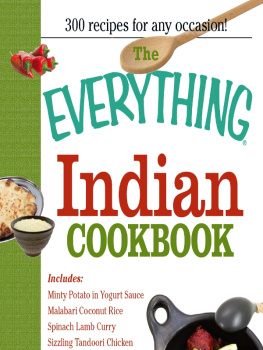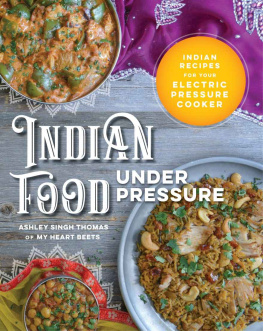Mann - The North Indian Cookbook: 30 Authentic & Exciting Recipes
Here you can read online Mann - The North Indian Cookbook: 30 Authentic & Exciting Recipes full text of the book (entire story) in english for free. Download pdf and epub, get meaning, cover and reviews about this ebook. year: 2014, genre: Home and family. Description of the work, (preface) as well as reviews are available. Best literature library LitArk.com created for fans of good reading and offers a wide selection of genres:
Romance novel
Science fiction
Adventure
Detective
Science
History
Home and family
Prose
Art
Politics
Computer
Non-fiction
Religion
Business
Children
Humor
Choose a favorite category and find really read worthwhile books. Enjoy immersion in the world of imagination, feel the emotions of the characters or learn something new for yourself, make an fascinating discovery.
- Book:The North Indian Cookbook: 30 Authentic & Exciting Recipes
- Author:
- Genre:
- Year:2014
- Rating:5 / 5
- Favourites:Add to favourites
- Your mark:
- 100
- 1
- 2
- 3
- 4
- 5
The North Indian Cookbook: 30 Authentic & Exciting Recipes: summary, description and annotation
We offer to read an annotation, description, summary or preface (depends on what the author of the book "The North Indian Cookbook: 30 Authentic & Exciting Recipes" wrote himself). If you haven't found the necessary information about the book — write in the comments, we will try to find it.
Mann: author's other books
Who wrote The North Indian Cookbook: 30 Authentic & Exciting Recipes? Find out the surname, the name of the author of the book and a list of all author's works by series.
The North Indian Cookbook: 30 Authentic & Exciting Recipes — read online for free the complete book (whole text) full work
Below is the text of the book, divided by pages. System saving the place of the last page read, allows you to conveniently read the book "The North Indian Cookbook: 30 Authentic & Exciting Recipes" online for free, without having to search again every time where you left off. Put a bookmark, and you can go to the page where you finished reading at any time.
Font size:
Interval:
Bookmark:
THE NORTH INDIAN COOKBOOK
30 AUTHENTIC & EXCITING RECIPES
Shelina Mann
Disclaimer
All contents copyrighted 2014 by Shelina Mann. All rights reserved worldwide. No part of this document or the related materials may be reproduced or transmitted in any form, by any means (electronic, photocopying, recording, or otherwise) without the prior permission of the author/ publisher.
The information and recipes contained within The North Indian Cookbook are based on extensive research conducted by the author. The sources used for the research are credible and authentic to the best of our knowledge.
In no event shall the author be liable for any direct, indirect, incidental, punitive, or consequential damages of any kind whatsoever with respect to the service, the materials, and the products contained within. This eBook is not a substitute for professional nutritional or culinary advice.
Table of Content
The Different Regions of Cooking in India
India is one of the most diverse countries in the world, and so is its cuisine. There are so many regional and cultural groups in the country, and all of them have their own styles of cooking and a variety of distinct and unique cuisines. Most of them, however, are curry dishes served with boiled rice and chapatis/rotis (traditional Indian bread). The diversity of regional Indian cuisine makes it difficult for you to typically generalize it in a simple manner. The most common regional cuisines of India include West Indian cuisine, North Indian cuisine, East Indian cuisine, Northeast Indian cuisine, and South Indian cuisine.
What Is Traditional North Indian Cooking?
Traditional North Indian cuisine often consists of vegetarian curries served with bread or rice sides. These curries are rich, containing nuts, spices, fruits, vegetables, and dairy products like cottage cheese, full cream milk, heavy fresh cream, and butter. Although there are some meat-based recipes as well, you wont see them as often in traditional Indian households as most people are vegetarians. Paneer, a fresh cheese prepared in India by curdling milk, is one of the most commonly used components in North Indian cuisine.
North Indian cuisine basically comes from four different areas of India: Kashmir, Uttar Pradesh, Rajasthan, and Punjab & Delhi. In Kashmiri curries, meat, lychees, and bananas are used often, and they are known for their sweet and mildly spicy flavor. Awadhi curries from the Uttar Pradesh are more well-known for using rich but expensive spices like saffron. Some of the distinct dishes from this region, like Samosas and Malai Kofta, are popular worldwide.
The curries from the Delhi and Punjab region mostly feature paneer and fresh cream and make abundant use of spice blends masalas. Rajasthani cuisine also uses paneer along with yogurt most commonly in their curries. However, their one yogurt-based curry sauce recipe, kadhi, is highly popular around the world.
What Do You Need To Make North Indian Food?
Before you start with traditional North Indian cooking, youll have to stock your kitchen up on necessary ingredients and hardware.
The necessary spices you need include anise seeds, black pepper powder, bay leaves, cardamom, cinnamon, chili powder, coriander, coriander powder, cloves, cumin seeds, cumin powder, fennel seeds, dry fenugreek leaves, mace, whole red chilies, turmeric, nutmeg, saffron, ginger, and garlic. You will also need ghee or clarified butter and paneer, a form of cottage cheese.
In the hardware section, you will need an Indian-style rolling pin, which is thinner and with a better grip. You will also need a kadai, which is like a wok. You will also need a flat skillet pan and, most importantly, a pressure cooker. You can easily buy a pressure cooker from an Indian store since it is needed in most North Indian recipes.
Now that you know about the North Indian cuisine, lets get down to some basic, wonderful recipes.
Must-Have Spices & Equipment
If you want to cook Indian food, there are some spices that you absolutely must have in your kitchen. Here are the top 10:

These are some must-have Indian spices you should keep in your kitchen if you want to try Indian recipes. Now that we have covered spices, its time we go over some basic cooking equipment you need for making Indian recipes:
Sharp Knives: There is a lot of chopping of vegetables for Indian recipes, particularly onion, so keep a good set of knives handy. Cutting Board: A cutting board provides the ideal surface for cutting and chopping vegetables. Saut Pan: In many ways similar to a frying pan, a saut pan has straighter sides. This makes it easier to toss food. Saucepan: You will need a small saucepan for the tadka, which is after you have completed the main recipe. Rolling Pin and Board: If you want to make authentic Indian Rotis, you need a rolling pin and a board. Oh, and dont forget a chapatti griddle as well. Spice Box: Given that there are so many spices you will be using, it is best you get a spice box to keep them in.This is some kitchen equipment you need to get before you can make Indian cuisine.
The Recipes
Phirni
A traditional dessert of North India, Phirni is an absolutely delicious rice pudding that is easy to make and can be prepared with minimal ingredients. So, thats the perfect way to get started with North Indian recipe learning!
Preparation Time:
1 hour
Servings:
Serves 5
Ingredients:
4 cups full cream milk 1/3 cup basmati rice cup sugar Peeled and sliced pistachios as needed A few rose petals tsp. green cardamom powderInstructions:
Soak the basmati rice in water for 20 minutes. Drain. Ground the rice with cup of milk to make a fine paste. In a large and heavy-bottomed vessel, bring the 4 cups of milk to a boil. Then, lower the heat and let it simmer until only 3/4th of the original quantity remains. Now, slowly add the rice mixture to the milk and continue to stir the whole time. Mix the rice mixture completely into the milk and let the milk thicken. Continue stirring continuously or the milk will stick to the bottom of the vessel. Add sugar and cardamom powder, and continue to stir. Make sure the sugar dissolves completely and no lumps are formed, making a smooth and creamy mixture. Turn the heat off. Pour out the Phirni in serving bowls and let it chill until the serving time. When you have to serve it, ladle it out in separate serving bowls and then garnish with rose petals and pistachios on top.
Font size:
Interval:
Bookmark:
Similar books «The North Indian Cookbook: 30 Authentic & Exciting Recipes»
Look at similar books to The North Indian Cookbook: 30 Authentic & Exciting Recipes. We have selected literature similar in name and meaning in the hope of providing readers with more options to find new, interesting, not yet read works.
Discussion, reviews of the book The North Indian Cookbook: 30 Authentic & Exciting Recipes and just readers' own opinions. Leave your comments, write what you think about the work, its meaning or the main characters. Specify what exactly you liked and what you didn't like, and why you think so.

